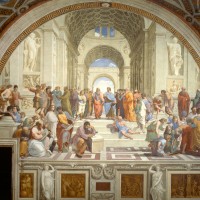| Painting Name | La fornarina (Portrait of a Young Woman) |
| Painter Name | Raphael |
| Completion Date | 1519 |
| Size | 85 cm × 60 cm (33 in × 24 in) |
| Technique | Oil |
| Material | Wood |
| Current Location | Galleria Nazionale d'Arte Antica Rome |
La fornarina was a skillful depiction by high-renaissance artist Raphael. It resembles with Leonardo’s Mona Lisa in terms of the posture, use of the model and the alleged idea behind the portrait. It also includes some elements of popular painting style Chiaroscuro which Raphael borrowed from Caravaggio.
La Fornarina, Raphael’s Mistress
It is said that the model seated for the portrait was Raphael’s real life model called Margarita Luti. The title of the painting means “the baker’s daughter”. According to Giorgio Vasari, the renaissance period art historian, Raphael was “a very amorous man’ and often looking for ‘amorous pleasures’. Allegedly, during his life he had many mistresses one after another, including daughters of his patrons.
Margarita Luti appeared in Raphael’s another portrait La Velata as well.
Symbolism of Exposed Left Breast
Nudity isn’t meaningless in arts. Neither in the current painting. In Classical art, exposed left breast is the symbol of divinity. This symbolism is indicated in the current painting by making model cover up her left breast with her right arm’s fingers. The same posture is also used in multiple paintings including the much known Birth of Venus by Botticelli. In Birth of Venus, newly born goddess Venus is trying to cover up her breasts in the same manner the lady in the current picture is leaving the left breast disclosed.
Sometimes, painters don’t specifically use any arm and just puts only left breast unveiled to represent the divine aspect of the subject instead of the amorous motifs. Examples are, Susanna and the Elders by Sebastiano Ricci and Louis XIII Crowned by Victory by Philippe de Champaigne.
Though, La Velata depicts Raphael’s mistress in full clothes, her pose is similar to the La Fornarina as she is having her right arm’s fingers near to her left breast.
The painting itself is revered for its bright face and clear eyes. Some speculates, that just like the conjured up theory of Mona Lisa that it’s the feminine portrayal of Leonardo da Vinci, in La fornarina, Raphael also has tried to depict his feminine side as he was very much influenced by Leonardo’s works. Raphael has also engraved his name on the woman’s left hand’s bend “RAPHAEL URBINAS” meaning Raphael of Urbino.
Though, nothing is for sure. Only thing which is absolute is that this ranks in Raphael’s one of the greatest works and a priceless piece from the period of high renaissance.




